
Dental flossing is an important part of maintaining good oral hygiene. It involves using a thin, flexible piece of string (floss) to remove food particles and plaque from between your teeth and along the gumline, areas that toothbrushes can’t reach effectively. Flossing helps prevent cavities, gum disease, and bad breath by cleaning between teeth where bacteria tend to build up.
There are two main types of dental floss:
- Waxed floss: Has a coating of wax, making it easier to slide between tight teeth.
- Unwaxed floss: It’s thinner and might be better for people with very tight teeth, though it can break more easily.
To floss properly:
- Take about 18 inches of floss.
- Wrap the ends around your fingers, leaving a few inches in between.
- Gently slide the floss between your teeth, curving it around each tooth in a “C” shape.
- Move it up and down to remove debris.
- Repeat this for every tooth, using a clean section of floss as needed.
Flossing once a day, ideally before bed, can make a big difference in your oral health!

